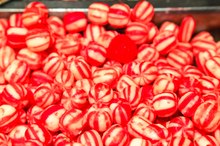Can Tomato or Vegetable Juice Change a Bowel Movement to Red?
One of the most unpleasant parts of being a mom of young children is, perhaps, the fact that you spend so much time changing diapers and wiping bottoms. While it can certainly be gross, keeping an eye on your child's bowel habits is important because changes can signal certain health problems. It's a good reason to pay attention to your own habits, too. If you notice that a bowel movement is red, consider the things your family has eaten recently because certain ones, such as tomato juice, can noticeably change the color.
Normal Bowel Movement Colors
There is a wide range of normal when it comes to bowel movements. Because food can influence what color a bowel movement is, most colors are nothing to worry about. All shades of brown and green are considered completely normal, according to MayoClinic.com. Brown, green and mustard-colored are all normal for babies. The exact color depends on the amount of bile you have in your digestive tract because bile interacts with enzymes produced during the digestive process and produces a variety of hues.
- There is a wide range of normal when it comes to bowel movements.
- Because food can influence what color a bowel movement is, most colors are nothing to worry about.
Tomato and Vegetable Juice
Dark Stool in Infants
Learn More
The appearance of red in a stool can be immediate cause for alarm because it often looks bloody. Bloody stool warrants immediate medical attention, but before you rush yourself or your child to the emergency room, keep a few things in mind. Drinking tomato juice or vegetable juice blends that contain tomatoes can cause stool to turn a reddish hue, according to MayoClinic.com. If the entire stool is red, it's likely because of the juice. If there are streaks of red along the sides, it could be blood caused by conditions such as hemorrhoids or a rectal injury.
- The appearance of red in a stool can be immediate cause for alarm because it often looks bloody.
Additional Food Culprits
Additional foods, such as beets, red gelatin, red fruit juices and red frozen desserts, can also cause stool to take on a reddish hue. Again, if the entire stool is the red color, it's likely because of the food. Tomato soup, cranberries and foods that contain red food dyes can also cause stool to change to a reddish color.
Tips and Considerations
Diarrhea Color in a Baby
Learn More
If you're unsure about the red color or if you or your children haven't consumed tomato juice, seek medical attention right away. Bloody stool can be caused by mild conditions, such as a bleeding hemorrhoid, but it can also be caused by more serious conditions, such as food poisoning. Keep track of how often it's happened so you can give the doctor as much information as possible, MayoClinic.com recommends. Your or your child's doctor might ask for a sample, so be prepared to collect one, if possible, before heading to your appointment.
- If you're unsure about the red color or if you or your children haven't consumed tomato juice, seek medical attention right away.
- Your or your child's doctor might ask for a sample, so be prepared to collect one, if possible, before heading to your appointment.
Related Articles
References
- MayoClinic.com: Stool Color: When to Worry
- MayoClinic.com: Baby Poop: What's Normal?
- MayoClinic.com: Rectal Bleeding
- Gardner TB, Hill DR. Treatment of giardiasis. Clin Microbiol Rev. 2001;14(1):114-28. doi:10.1128/CMR.14.1.114-128.2001
- Tan CK, Chao CM, Lai CC. Green feces. QJM. 2013;106(3):287. doi:10.1093/qjmed/hcr271
- Levitt MD, Duane WC. Floating stools--flatus versus fat. N Engl J Med. 1972;286(18):973-5. doi:10.1056/NEJM197205042861804
- Andrews CN, Storr M. The pathophysiology of chronic constipation. Can J Gastroenterol. 2011;25 Suppl B:16B-21B.
- Oude munnink BB, Van der hoek L. Viruses Causing Gastroenteritis: The Known, The New and Those Beyond. Viruses. 2016;8(2). doi:10.3390/v8020042
- Hansson GC. Role of mucus layers in gut infection and inflammation. Curr Opin Microbiol. 2012;15(1):57-62. doi:10.1016/j.mib.2011.11.002
- Panda H, Andrews CN. Constipation in a 40-year-old woman. CMAJ. 2016;188(4):277-278. doi:10.1503/cmaj.150761
- Beckingham I J. Investigation of liver and biliary disease. BMJ. 2001 Jan 6; 322(7277): 33–36.
- Rose C, Parker A, Jefferson B, Cartmell E. The Characterization of Feces and Urine: A Review of the Literature to Inform Advanced Treatment Technology. Crit Rev Environ Sci Technol. 2015;45(17):1827-1879. doi:10.1080/10643389.2014.1000761
- Ferguson MA. Office evaluation of rectal bleeding. Clin Colon Rectal Surg. 2005;18(4):249-54. doi:10.1055/s-2005-922847
- Kim BS, Li BT, Engel A, et al. Diagnosis of gastrointestinal bleeding: A practical guide for clinicians. World J Gastrointest Pathophysiol. 2014;5(4):467-78. doi:10.4291/wjgp.v5.i4.467
- Ip S, Sokoro AA, Buchel A, et al. Use of fecal occult blood test in hospitalized patients: survey of physicians practicing in a large central Canadian health region and Canadian gastroenterologists. Can J Gastroenterol. 2013 Dec;27(12):711-6.
Writer Bio
Sara Ipatenco has taught writing, health and nutrition. She started writing in 2007 and has been published in Teaching Tolerance magazine. Ipatenco holds a bachelor's degree and a master's degree in education, both from the University of Denver.









